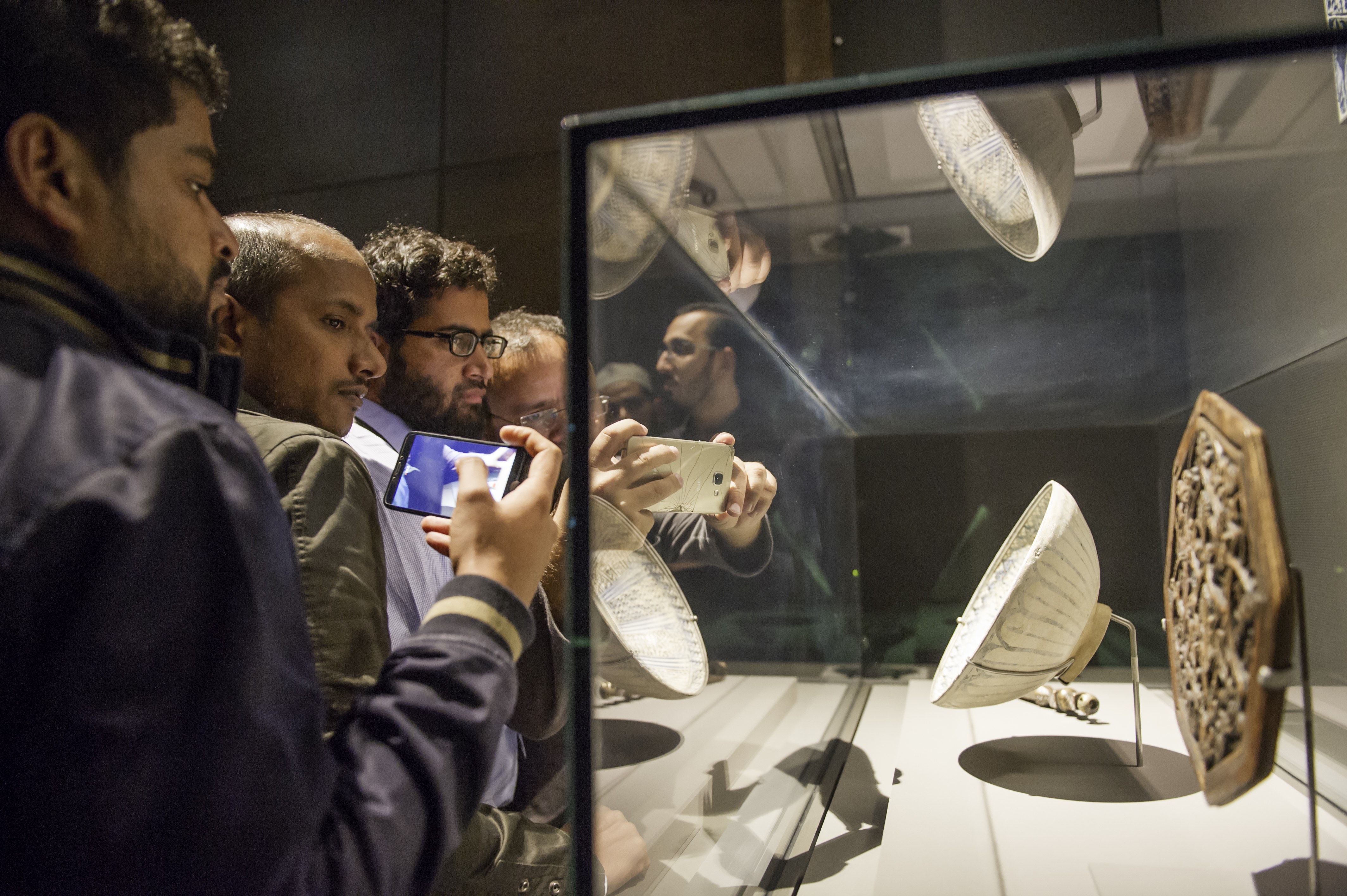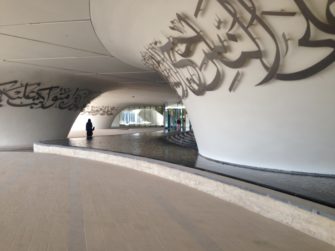
Having grown up in a society that fails to appreciate beauty and often condemns its expressions as an act of evil, I am amazed by the dazzling history of Muslim civilization. I always wonder how Muslims, such as the scholars I have encountered in New Delhi and many other parts of northern India, can claim today to be the heirs of their predecessors if they do not value beauty as transcendent and divine with the same vigor and enthusiasm.
Appreciation of beauty stimulates imagination and innovation, and historically Muslims excelled at its expressions. They produced the finest architecture, music, calligraphy, and other crafts. It all began with Muslims setting their feet on the fertile soil of the cradles of ancient civilizations: Egypt, Persia, the lands between the Tigris and Euphrates, etc. They mingled old traditions with the new spirit of iḥsān, a comprehensive concept, writes Oludamini Ogunnaike, denoting the “sense of beauty and excellence—at once aesthetical, ethical, intellectual, and spiritual.” Their understanding of iḥsān drew from the verses of the Quran that give a big picture of the metaphysical beauty of God, and a scenic view of Jannah (Paradise) with its palaces sculptured from gems, surrounded by gardens, where streams of milk and honey flow. As many traditions including Islam assert, ‘God is beautiful and loves beauty.’ Religious inspiration is evident in the designs of the elegant monuments and mosques from Spain to Indonesia. The profound beauty of these structures and decorative art still evokes ecstasy in their beholders.
Ogunnaike defines Islamic art as ‘silent theology’ that successfully holds the picture of Islam intact against contemporary virulent propagandas. He further says, “To many, the silent theology of Islamic art can speak more profoundly and clearly than the most dazzling treatise, and its beauty can be more evident and persuasive than the strongest argument.” I would add to Ogunnaike’s point that past Muslim innovations in beauty serve as a source of inspiration and pride for Muslims even today.
However, some modern Muslim puritanical movements have challenged the role of beauty in Islam. The ideologues of these movements have fomented disregard of Islamic art among the ʿulamā and hence the masses. During my days of madrasa schooling, I heard some of my teachers and peers argue that art is not worth pursuing. It distances man from the remembrance of God and requires an excessive amount of money and resources, it is said. It is no surprise that Aurangzeb, a Mughal Emperor who did not appreciate art very much, is dearer to the ʿulamā than Shāh Jahān, the Emperor who built the Taj Mahal. Sufis are also discredited by these ʿulamā members for their practice of arranging musical gatherings for seeking aesthetic experiences in the presence of the Divine. These reductionist Muslims often view Islam as a sort of strictly ritualistic system and deprive it of its aesthetic heritage.

My experience of Islam has been very diverse between the madrasa and the university. Practicing conventional or ritualized Islam in my days of madrasa schooling seemed very simple. After coming to the university, however, my awareness of Islam grew in complexity with my increasing familiarity with its history and the civilization it produced. My readings about historical and religious understandings of Islam suggested that there is a gap between the way Islamic civilization thrived in the past and how Islam is practiced today. I admire the Muslim genius and fellow citizens of other faiths who contributed to this civilization. But I am also disturbed when I read about the paintings depicting humans on the walls of Qusayr in Jordan built by Walid I, the Umayyad Caliph in the first century of Islam, contrary to the centuries-old fatwa condemning representational art and prohibiting images of living beings (p. 271). This fatwa drew its validity from the hadiths (prophetic traditions) that forbade representational art, considering it a grave sin.[1] The question was whether the Umayyads disregarded the prophetic traditions altogether or if they had a different understanding of them. Debates on representational art developed a new dimension after the invention of the camera. In the Indian subcontinent, the permissibility and impermissibility of photography is still among the most debated religious issues. I faced such contradictions throughout my study of Muslim history. The question was, who should I consider wrong? The conventional view maintained by the orthodox ʿulamā is to perceive the religiosity of the rulers who encouraged and patronized arts with suspicion.
My amazement with Islam deepened as I delved more seriously into the intellectual history of Islam. I found an opportunity to do this in the Madrasa Discourses program, directed by Ebrahim Moosa and Mahan Mirza, Professors of Islamic Studies both based at the University of Notre Dame. This program teaches madrasa graduates modern science and Western philosophy in such a way that the students may develop skills to answer the modern challenges posed to Islam. This past semester we had a long discussion on ‘tradition,’ imagining it as a long rope that connects the past to the present. To keep it going, the people of the tradition have to add new threads to this rope in their respective times. If the people treat tradition otherwise, it will lose its viability. Similarly, Islamic art is one among several threads of Muslim tradition. There is a sense of continuity and progress in it from the very onset up to the modern times. Many of the expressions of this art have been lost, but many are still extant and make us recall the ingenuity and sacredness of the tradition of Islamic art. The best way to perceive it is to experience it personally in art museums, musical concerts, and by visiting renowned sites and monuments.
As a part of the program, select madrasa-educated students from India and Pakistan had a chance to visit the Museum of Islamic Art in Doha, Qatar during the winter intensive in the last week of December 2017. The museum is located on an artificial island flanked by two huge lawns with a bridge in the middle that connects the old city to the museum. We were told that the architectural design of this museum was inspired by the famous 9th century Ibn Tūlūn Mosque of Cairo. An exquisite edifice, this museum is often portrayed as an example of generating new threads into the old rope of tradition. Inside the museum, it was as if we were visiting our past. A collection of metalwork, glasswork, textiles, manuscripts, and ceramics are housed there representing Islamic arts throughout the centuries. Examining them closely, I admired the inspiration they drew from the world that they lived in and from the tradition with which they were entrusted. Artifacts in the museum such as colorful rugs and silks with figurative designs, griffins crafted on tiles or a sphinx-faced lusterware ewer were evidently the mixture of creative Muslim imagination with the local cultures and civilizations of the lands Muslims came to inhabit.

I was surprised again, imagining the past to be so beautiful and so appreciative of arts in comparison to my present society. Questions troubled me: what was it that disconnected the vast majority of South Asian Muslims from this vibrant tradition? Why do we no longer show the same enthusiasm toward the spirit of creativity? Why do we fail to discuss and give due appreciation to aesthetics? There could be many reasons. I had a chance to discuss my concerns with Professor Ebrahim Moosa, who was with us at the time. I had already thought of an explanation for the dissonance I was experiencing: the recent dominance of a ritualistic and ahistorical understanding of Islam that was confined, in great part, to prayers only. I am not sure whether Prof Moosa agreed with my argument, as he added that Muslims no longer feel confident in performing creativity or talking about aesthetics as they did before. This may be one of the factors that killed Islam’s thriving artistic and aesthetic tradition.
Apart from the museum, we also witnessed an extensive display of magnificent architectural designs in the Education City in Doha. I think that Qatar has devoted much of its resources in reviving the aesthetic tradition of Islam and can serve as an example to Muslims of other nations. Muslims have historically seen beauty as sacred and tried to seek perfection in its expressions. Debates about aesthetics, arts, and erstwhile Muslim experiences should be introduced into madrasa education and students should be exposed to the historical meanings of their tradition. We should engage with the questions: What motivated many rulers and elites of Muslim society to patronize such arts, especially the representation of figures that were considered prohibited by orthodox scholars? Was it an act of indifference towards Islamic law or were there some historical and cultural impulses that led the practitioners and patrons of the arts to define the laws differently? There is a need to analyze the seemingly contradictory practices of past Muslims with the dominant contemporary orthodox Islamic tradition. This can help us understand the significance of art in the robust and cosmopolitan nature of Islamic civilizational tradition.
[1] Bukhārī mʿ Fathul Bārī, Vol 10, pp 314, 316, 323. The Hadiths are cited in Tasvīr ke Sharaʿī Aḥkām (The Rulings of Sharia about Making Images and Photography) by Muftī Muhammad Shafīʿ, published by Idāratul Mʿārif, Karachi, Pakistan




